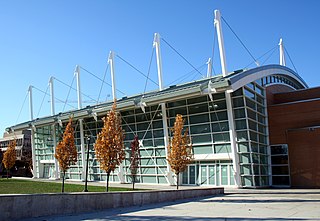
An architect is a person who plans, designs and oversees the construction of buildings. To practice architecture means to provide services in connection with the design of buildings and the space within the site surrounding the buildings that have human occupancy or use as their principal purpose. Etymologically, the term architect derives from the Latin architectus, which derives from the Greek, i.e., chief builder.

Beatrix Cadwalader Farrand was an American landscape gardener and landscape architect. Her career included commissions to design about 110 gardens for private residences, estates and country homes, public parks, botanic gardens, college campuses, and the White House. Only a few of her major works survive: Dumbarton Oaks in Washington, D.C., the Abby Aldrich Rockefeller Garden on Mount Desert, Maine, the restored Farm House Garden in Bar Harbor, the Peggy Rockefeller Rose Garden at the New York Botanical Garden, and elements of the campuses of Princeton, Yale, and Occidental.

Landscape architecture is the design of outdoor areas, landmarks, and structures to achieve environmental, social-behavioural, or aesthetic outcomes. It involves the systematic design and general engineering of various structures for construction and human use, investigation of existing social, ecological, and soil conditions and processes in the landscape, and the design of other interventions that will produce desired outcomes.

A landscape architect is a person who is educated in the field of landscape architecture. The practice of landscape architecture includes: site analysis, site inventory, site planning, land planning, planting design, grading, storm water management, sustainable design, construction specification, and ensuring that all plans meet the current building codes and local and federal ordinances.

Landscape design is an independent profession and a design and art tradition, practiced by landscape designers, combining nature and culture. In contemporary practice, landscape design bridges the space between landscape architecture and garden design.
Building design, also called architectural design, refers to the broadly based architectural, engineering and technical applications to the design of buildings. All building projects require the services of a building designer, typically a licensed architect. Smaller, less complicated projects often do not require a licensed professional, and the design of such projects is often undertaken by building designers, draftspersons, interior designers, or contractors. Larger, more complex building projects require the services of many professionals trained in specialist disciplines, usually coordinated by an architect.
Garden design is the art and process of designing and creating plans for layout and planting of gardens and landscapes. Garden design may be done by the garden owner themselves, or by professionals of varying levels of experience and expertise. Most professional garden designers have some training in horticulture and the principles of design. Some are also landscape architects, a more formal level of training that usually requires an advanced degree and often a state license. Amateur gardeners may also attain a high level of experience from extensive hours working in their own gardens, through casual study, serious study in Master gardener programs, or by joining gardening clubs.
Design–build, also known as alternative delivery, is a project delivery system used in the construction industry. It is a method to deliver a project in which the design and construction services are contracted by a single entity known as the design–builder or design–build contractor. It can be subdivided into architect-led design–build and contractor-led design–build.
Texas A&M University School of Architecture is the architecture school of Texas A&M University.
A garden designer is someone who designs the plan and features of gardens, either as an amateur or professional. The compositional elements of garden design and landscape design are: terrain, water, planting, constructed elements and buildings, paving, site characteristics and genius loci, and the local climatic qualities.

The Landscape Institute (LI) is a UK based professional body for the landscape profession. Its membership includes landscape architects, urban designers, landscape planners, landscape scientists and landscape managers. The LI also has a category for academic members.

Warren Henry Manning was an American landscape designer and promoter of the informal and naturalistic "wild garden" approach to garden design. In his designs, Manning emphasized pre-existing flora through a process of selective pruning to create a "spatial structure and character." An advocate for the conservation of the American landscape, Manning was a key figure in the formation of the American Society of Landscape Architects and a proponent of the National Park System.

Frank Albert Waugh was an American landscape architect whose career focused upon recreational uses of national forests, the production of a highly natural style of landscape design, and the implementation of ecology as a basis for choices in landscape design. He essentially pioneered the role of the landscape architect as an integral part of national forest design and development through such projects as the Mount Hood Scenic Byway and the Bryce Canyon scenic roadway. His ideas spread via his diverse writings, including Recreation Uses in the National Forests and The Natural Style in Landscape Gardening. He also wrote prolifically about education, agriculture, and social issues in such works as The Agricultural College and Rural Improvement.
Karl Linn was an American landscape architect, psychologist, educator, and community activist, best known for inspiring and guiding the creation of "neighborhood commons" on vacant lots in East Coast inner cities during the 1960s through 1980s. Employing a strategy he called "urban barnraising," he engaged neighborhood residents, volunteer professionals, students, youth teams, social activists, and community gardeners in envisioning, designing, and constructing instant, temporary, and permanent gathering spaces in neighborhoods, on college campuses, and at sites of major conferences and events. "Linn is considered 'Father of American Participatory Architecture' by many academic colleagues and architectural and environmental experts of the National Endowment for the Arts."

Architectural engineering or architecture engineering, also known as building engineering, is a discipline that deals with the engineering and construction of buildings, such as structural, mechanical, electrical, lighting, environmental, climate control, telecommunications, security, and other areas. It is related to both architecture and civil engineering, and distinguished from architectural design, as an art and science of designing buildings.
The Cal Poly Pomona College of Environmental Design is a college part of the California State Polytechnic University, Pomona. The college houses over 1,600 students; making it one of largest environmental design programs in the United States. The college offers bachelor's degrees in five departments, as well as three master's degree programs. It is the only academic unit within the California State University system to be associated with a Pritzker Prize laureate.

Sustainable gardening includes the more specific sustainable landscapes, sustainable landscape design, sustainable landscaping, sustainable landscape architecture, resulting in sustainable sites. It comprises a disparate group of horticultural interests that can share the aims and objectives associated with the international post-1980s sustainable development and sustainability programs developed to address that humans are now using natural biophysical resources faster than they can be replenished by nature.

A gardener is someone who practices gardening, either professionally or as a hobby.
A Bachelor of Environmental Design, (B.EnvD.), is an undergraduate course of study. Similar in nature to a pre-law degree, a B.EnvD is designed as preparatory undergraduate training for a professional course of study in architecture, landscape architecture, or urban planning, and is one of several degrees offered as preparatory training for the Master of Architecture degree. An alternative three-year Master of Architecture exists for people with a bachelor's degree not related to design, the M.Arch I degree. A Bachelor of Environmental Design should not be confused with a Bachelor in Environmental Studies, which though similar, does not train one for graduate professional study in architecture, landscape design, or urban planning. Environmental Design degree programs generally take four years of full-time study to complete, and many institutions allow a specialty emphasis within urban planning, architecture or landscape architecture. Other pre-professional degrees include the B.S. in Architectural Studies, B.A. in Architecture, the B.S. in Architecture, and the B.S. in Construction Management. Though the Bachelor of Environmental Design is not accredited by the National Architectural Accrediting Board NAAB, like other college degrees, programs in Environmental Design are accredited through their host-institution schools by various regional agencies, such as the Middle States Association of Colleges and Schools, or the North Central Association of Colleges and Schools. The Bachelor of Environmental Design should not be confused with the M.Arch or the five-year accredited B.Arch degree.











